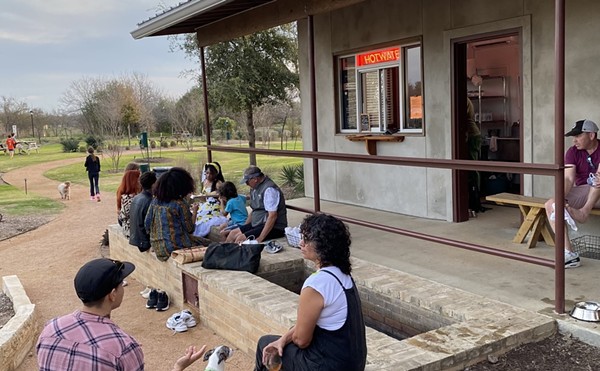Three years ago, food trucks were but a pipe dream for would-be restaurateurs who sought a lower overhead than that of a brick-and-mortar eatery. Even as trucks afforded owners mobility and a buzzy hook, it’s not been the easiest of roads to navigate: ancient city ordinances and insane South Texas weather are just some of the road blocks forcing mobile kitchens to take a detour since 2010.
Enter food truck parks. Hitching posts such as Boardwalk on Bulverde, The Point Park & Eats, Alamo Street Eat Bar and The Block have provided local rolling restaurants with more stability so long as both parties put some skin in the game. But security isn’t always guaranteed. A perfect example of the precariousness of the courts is the 281 Food Park, located five miles north of the 1604 and 281 interchange, which went through a litany of owners and versions before finally shutting down earlier this year.
What motivates an owner to turn a lot into a smorgasbord of tiny eateries? Whether it’s joining the mobile food movement, taking entrepreneurial baby steps, safeguarding a neighborhood or providing a base location for newbie trucks, each local owner has a goal as varied as their tenants’ menus.
The Creator
There’s no food truck park discussion without mentioning the Boardwalk on Bulverde (14732 Bulverde). As the first established park in San Antonio, the Boardwalk, or BOB, has been somewhat of a guinea pig location for food truck owners and competing park operators.
The Boardwalk, owned and operated by Cameron Davies, held its soft opening in late December 2010 with a smattering of trucks including Bistro Six (which has since abandoned its wheels to open Knife & Fork Gastropub), DUK Truck, G&G Mobile Bistro (closed as of early 2011), K-Hill BBQ Company, Saweet Cupcakes (which has had two different owners since opening), Tin Can Tacos (gone the way of the Dodo) and Wheelie Gourmet.
Davies also owns Cruising Kitchens, which has played an essential role in refurbishing food trucks in San Antonio and across Texas, so it only made sense for him to provide a place for trucks to dip a wheel in the mobile kitchen pool.
“We built the park with our hands, and we had the background [because of Cruising Kitchens], so we knew what the trucks would need to operate,” Davies said while admitting there’s been a bit of a learning curve. “It’s an ongoing challenge to figure out layout for trucks to come in and out, how to power the trucks and visibility.”
One of Davies’ biggest struggles has been figuring out electricity requirements for said trucks, some of which are sizably bigger than those built three years ago. This has led Davies and co. to install a new electric panel at the park. According to Davies, renting a space at BOB will run $500 with an additional $50 per month to plug into the park’s electricity (which helps stave off generator use for the trucks).
Running the park isn’t his sole source of income, said Davies, who estimates he’ll build some 70 custom trucks by year’s end. “I do it for the trucks and the community; my business is next door,” he said.
As far as other parks go, Davies insists he sees them as friendly competition that serve to “raise awareness about mobile food.”
Know Your Code
The Boardwalk may have served as an early mock-up for food truck park success, but parks going into the heart of the city were met with a few more obstacles including infrastructure and an archaic rule, which asked parks to have written permission from any food establishment within 300 feet in order to park.
For instance, Jody and Steve Newman had looked into another Southtown spot before opening the Alamo Street Eat Bar (609 S Alamo) in March 2012. The original location would have required the Newmans to put in electricity, chairs and restrooms. When the location formerly known as the Acapulco Drive-Inn became available, the Newmans decided to lease the space.
“Alamo Street is about location, the trucks are getting prime real estate with a fun, organic atmosphere. We think it keeps the entrance to Southtown alive and kicking,” Jody Newman said of the plot that was slated to become a parking lot.
Yet the primo location came with its own unique risk, in the form of city ordinances that previously kept mobile food vendors from San Antonio’s core. The bustling area was already chockablock with restaurants; under the original ordinance, any of them within 300 feet of Alamo Street would be able to deny the permission to the various food trucks hoping to sell their wares.
This was amended slightly during the implementation of the Downtown Food Trucks Pilot Program in April 2012, which had hoped to infuse life into forgotten areas, but was a tough sell for truck owners who had to apply for a permit and get written permission from surrounding restaurants to use their restroom facilities. The program more or less fizzled out, but it did lead to more permanent changes for food truck courts.
A series of meetings, along with support from District 1 councilman Diego Bernal and the City Manager’s office, “which wanted the food truck ordinance to be smart progress for San Antonio,” according to Jody, helped herald amendments to City Code Chapter 35 of the Unified Development Code and Chapter 13 of the Food and Handlers Code of Ordinances in May 2012.
Recommendations came from the city zoning department and Metro Health. These changes allowed for the licensing of mobile food courts as long as they met certain requirements including parking, restrooms, electricity, potable water and sewage disposal (the parks would act as a commissary for the trucks, a place to replenish supplies and flush out their liquid waste storage. Currently, there are seven approved commissaries in San Antonio).
This also allowed for trucks to stay parked overnight, forgo daily commissary visits and do away with extra storage for liquid waste. The mobile food court license (COSA’s term, not ours) also overrides the 300-foot rule trucks had to abide by. Currently, two licensed mobile food courts exist, the Alamo Street Eat Bar and The Block, according to Steve Barscewski, sanitarian services manager at Metro Health.
“Half the time, park plans don’t come to fruition. We’ve looked at up to 15 parks at one point and of the original group, there are about six or seven,” Barscewski said.
Penciling It In
For Jon Onstead, the idea for the The Block first came to him in 2011 while on the road to Austin. The 2009 University of Texas at San Antonio alum (with a concentration in real estate and finance) was a practicing realtor when he started looking into opening a park. He remembers the date the amendments passed clearly.
“It was like my birthday, May 27, 2012,” he said.
Onstead wouldn’t start construction on The Block before the amendments to both the UDC and the health code were in place, claiming it would have been too risky for him and the trucks.
Since its grand opening in September, The Block (14530 Roadrunner Way) has been busy catering to hordes of hungry roadrunners and surrounding residents in UTSA’s northern neighborhood. The park is one of the most curated yet: Trucks sit next to a plush green lawn that’s coupled with an expansive xeriscaped area for tables and a new bar building.
Again, stability and visibility comes at a price. Leasing a space at the Block costs $1,500 per month, but Onstead’s given the trucks an option to sublease their rental if the opportunity to cater an event were to arise.
Onstead also consulted with Newman on how to run the park as far as menu variety, something Alamo Street Eat Bar also employs to avoid competing truck offerings. Menu exclusivity is often considered when renting out a spot at Alamo Street Eat Bar. For $850 per month there, trucks have access to trash cans and dumpster services, electricity, seating, gray water disposal, grease traps, a three-bowl cleaning station (which equals an annual commissary membership valued at around $200), advertising and social media promotion.
When it comes to scheduling trucks, Denise Aguirre of The Point Park & Eats (24188 Boerne Stage), gives the vendors a deadline of every 19th of the month to send in preferred dates. From there, Aguirre spends two days manipulating the schedule so trucks won’t compete directly with one another. Rent at the park varies from $25-$65 per day with an additional overnight parking fee; music acts, clean up and social media promotion are included in the price.
Although The Point is technically certified as a bar through Bexar County (no mobile food court licenses were available when The Point opened in early 2012), Aguirre and partner Noel Cisneros have outfitted the park with electricity for the trucks, plentiful shade and a playground.
SpiceSea Gourmet, which schedules lunches throughout the city, sees parks as a must. “I have a steady following at the parks. It’s also a way for people to have my food at nights or on the weekend. It opens up my schedule to accommodate their busy lives,” Whitney Matthews, owner of SpiceSea Gourmet, said. “Additionally, I know that I will have customers since food truck parks are becoming destinations.”
Since opening, parks have sought über-specific niches: Alamo Street Eat Bar caters to an urban crowd; The Point Park & Eats Park owners focus on bringing a taste of downtown to a suburban crowd; The Block’s got the UTSA area covered. Finding a sweet spot helps courts succeed and minimizes fierce competition. Want to drive from your Southtown home just to check out The Point at 1604 or vice versa? Didn’t think so.
The Renegades
Still there are areas where food trucks congregate on vacant lots near 410 and Nacogdoches, or most recently, Mission #6, located on South St. Mary’s across from the Family Dollar.
Gabriel Cardenas and wife Eva Rangel Cardenas (owners of The Fridge), along with owners of Gourmet on the Fly, Sabores Food Truck and Slider Provider have all tried to make Mission #6 a temporary home. As an unlicensed food truck park, it doesn’t yet offer onsite amenities found at more established courts. In lieu of the heavy upfront infrastructure investments required by licensing, Mission #6 owner Chris McKnight, who declined to comment for this article, has instead got right with the health department by providing customers with bathroom facilities at nearby Southtown 101 and getting food vendors in a 300 foot radius to sign-off on Mission #6’s existence. As of now, there is no onsite electricity offered to trucks, not ideal for regular operation. Currently, the spot focuses on attracting trucks and crowds during Southtown’s popular First Friday events and has been open on Saturday as well.
“It’s hard to get trucks out there, especially going into October,” said Cardenas, speaking about Saturday truck line-ups. When the lot was first announced in mid-August, McKnight had asked Institute of Chili truck owner Ana Fernandez to curate a lineup of trucks. Fernandez, whose truck is parked part-time at Alamo Street, has since minimized her role with the project, citing a lack of infrastructure.
“There are benefits to being permitted versus not,” Barcewski said while dishing on a host of “issues” that could come up for spots including zoning, plumbing and electrical concerns that could result in notices or citations for the trucks.
Say She Ate’s Brandon McKelvey reiterated that sentiment. As a member of the San Antonio Food Truck Association who finds his own gigs, McKelvey’s take on parks is wary.
“Newer parks are popping [up], not putting in electricity … if you’re not providing anything why should we pay to park there?” McKelvey asked. While he might dabble in the occasional park stop, McKelvey’s sticking to his guns and finding gigs on his own in an effort to keep costs as low as possible.
The Fridge is also highly mobile—it spends its nights at Leon Bar, Uptown Studios, Southtown 101, Rackspace (a “cash cow” for trucks which provides electricity while not charging the trucks to park at The Castle), along with occasional events at the Boardwalk, where the truck held its grand opening in April 2013.
Putting in the necessary elbow grease and monetary investment might be something The Fridge looks in to in the next few months, but the relatively new truck isn’t ready to make any commitments just yet.
“Running a park is probably 20 times harder than running a truck,” Cardenas said. “There are egos involved with truck owners. We have to ask ourselves if we want that headache.”

















